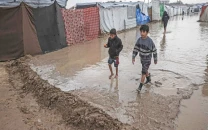Social media misinformation, the real storm around Hurricane Milton?
Was the destructive hurricane a product of Nature or can the government control weather patterns for political gain?

As Hurricane Milton approached Florida, the region braced for impact, but the most damaging storm did not come from the skies.
Instead, it emerged from social media, where misinformation about the hurricane proliferated rapidly, overshadowing the very real devastation caused by the natural disaster.
Thankfully, the damage from Hurricane Milton wasn’t as severe as anticipated, thanks to a sudden weakening of the storm and a slight shift in its path that spared major areas like Tampa.
However, the aftermath was still grave: a series of tornadoes and floods resulted in at least 16 fatalities and displaced tens of thousands.
Many parts of western Florida were inundated with mud, while others faced the daunting task of sifting through debris from destroyed infrastructure.
More than 2 million residents were left without power, and fears of contracting diseases from bacteria lingering in the floodwaters escalated.
The crisis was compounded by the residual devastation left by Hurricane Helene.
Meteorologists and emergency services worked diligently to provide warnings and issue evacuation orders, which likely prevented even more casualties.
But as the storm drew closer, a faction of right-wing commentators and social media influencers began to suggest an outlandish narrative: that the government had somehow manufactured the hurricane.
These claims were rooted in conspiracy theories that falsely posited that the government could control weather patterns for political gain.
For instance, some figures on social media claimed that changing wind-speed forecasts meant that the Weather Channel had lost its credibility. Influencers like Catturd alleged that Democrats had engineered Hurricane Milton to create chaos in Florida’s election system.
The misinformation spread quickly, with some users even accusing meteorologists of “manifesting” the storm through their forecasts, leading to death threats against weather professionals attempting to clarify the situation.
As the chaos unfolded, emergency responders were not only tasked with rescuing those affected by the storm but also with combating rampant misinformation that complicated their efforts.
The assistant fire chief of Pensacola recorded a Facebook video urging residents to disregard the unfounded rumors circulating online. “I’m trying to rescue my community,” he lamented. “I ain’t got time to chase every Facebook rumor.”
His frustration highlighted the reality that officials were battling two storms: the physical devastation of the hurricane and the onslaught of misinformation that threatened public safety.
Social media became a breeding ground for baseless claims, including calls for residents to form militias against FEMA staff and plans to dismantle Doppler radar systems, mistakenly believed to be controlling the weather rather than simply detecting it.
Such delusions distracted from real issues, including the plight of factory workers and incarcerated individuals who remained in harm's way during the hurricanes.
In the wake of Hurricane Helene's destruction in the southeastern US, misinformation and conspiracy theories surged across social media platforms, especially TikTok.
Posts, many of which garnered millions of views, incited calls for violence against Federal Emergency Management Agency (FEMA) personnel, falsely accusing the agency of blocking essential aid to hard-hit areas.
International media identified multiple TikTok videos urging violence against FEMA employees. One particularly alarming video with over 204,000 views warned that failure to assist hurricane victims could lead to accusations of treason against FEMA workers, implying they could face severe consequences from citizens.
Another sponsored video labeled FEMA personnel as “Enemies of the State” and called for them to be arrested or harmed for obstructing rescue efforts.
Misinformation also sparked claims that FEMA was preventing evacuations by closing roads and bridges, leading to aggressive comments like “Run FEMA over. Pretty simple.” Furthermore, users promoted the idea of civil war and revolution, suggesting that recent events might trigger significant unrest.
One video speculated that the government might implement martial law to protect FEMA, indicating a growing belief that the federal response to disasters is part of a larger conspiracy.
Blame has been directed at social media platforms for allowing this wave of misinformation to flourish.
Elon Musk’s management of X has enabled conspiratorial voices to thrive, while Facebook and Instagram have significantly reduced their content moderation efforts.
YouTube profits from sensationalist content, and TikTok influencers dominate discussions, often drowning out factual reporting. The rapid spread of misinformation poses a significant challenge for those attempting to coordinate effective recovery efforts in the wake of the disaster.
As misinformation spread, the credibility of credible news sources and emergency services began to erode. Even as some far-right figures recognized the dangers of spreading unfounded claims, the damage to public trust had already been inflicted.
Representative Chuck Edwards from North Carolina was among those who began to push back against the chaos, emphasizing the need for accurate information during a crisis.
The fallout from Hurricane Milton illustrates a critical lesson: misinformation can be just as destructive as the disasters themselves.
The community's resilience in the aftermath will depend on its ability to sift through the noise of social media and rely on credible sources for information.
As Florida begins to recover, addressing the rampant misinformation surrounding Hurricane Milton will be just as crucial as rebuilding the physical infrastructure left in tatters.



















COMMENTS
Comments are moderated and generally will be posted if they are on-topic and not abusive.
For more information, please see our Comments FAQ